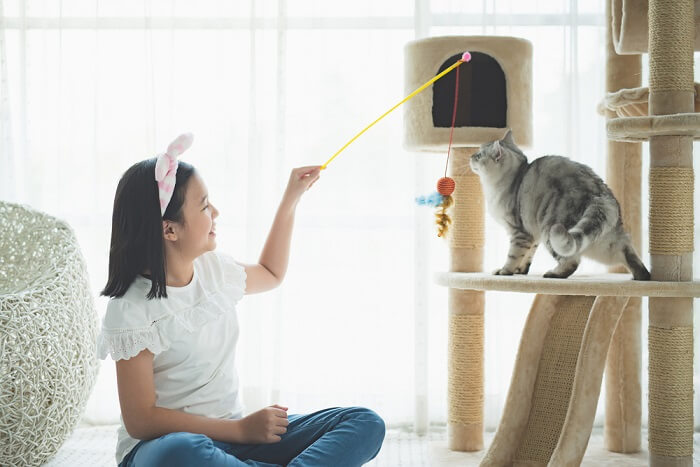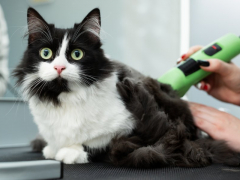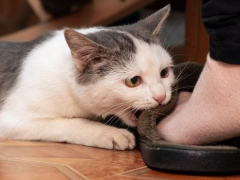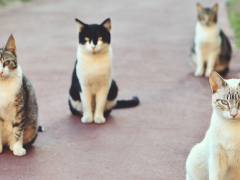
Patuss92 / Shutterstock.com
Some people believe training a cat is impossible, but you can achieve it with the proper techniques and patience. Clicker training works and can help teach your cat new tricks, improve their behavior, and strengthen your relationship. This article will discuss the benefits of clicker training and teach you how to clicker train a cat.
What Is Clicker Training?
Clicker training is a positive-reinforcement method that rewards an animal for exhibiting desired behaviors. Since the 1950s, marker training has been a fun and humane method popular with animal trainers across various species, from marine mammals to working animals.
It involves using a small device called a clicker or another type of marker (for instance, using a whistle with dolphins and other marine mammals). When the animal performs the desired behavior, you “mark” that exact moment with a click, then reward the pet with a treat. This approach reinforces the desired behavior, making it likely that your cat will repeat those positive actions in the future.
Why Clicker Train a Cat?

Clicker training for cats provides many benefits that go beyond simply teaching them tricks. Melina Grin / Cats.com
Clicker training cats offers numerous benefits. It provides mental and physical activities that stimulate a cat’s instincts and intelligence, which can help reduce behavioral problems and enhance their quality of life. The investment in training promotes a well-adjusted cat and enriches owners’ lives, contributing to a happier, healthier, and more harmonious household.
Here is a more detailed look at the various benefits of cat clicker training:
- Emotional wellness: Training significantly reduces negative emotions like fear, anxiety, boredom, and aggression. A well-trained cat is less likely to demonstrate unwanted behaviors that stem from these feelings.
- Cognitive development: Training provides intellectual encounters that promote learning and problem-solving skills. For example, teaching a cat to stop counter-surfing involves critical thinking for the cat and their owner.
- Positive behavior reinforcement: Rather than employing punishment, practical training focuses on rewarding desired behaviors, which strengthens you and your cat’s bond.
- Behavior modification: Through clicker training, kittens and cats can learn new behaviors, which can be beneficial in altering problematic habits they might have developed, like door dashing or couch scratching.
- Physical and mental stimulation: Harness and agility training provide daily mental stimulation and physical exercise that keeps your cat active and reduces the chances of obesity and other health issues.
- Socialization and conflict prevention: Clicker training can help introduce a new kitten to a resident cat or dog, helping establish a harmonious coexistence. Owners can prevent conflict with other animals in the house by training cats to respond appropriately to various situations, leading to a safer home environment.
- Health care compliance: Cats trained to accept medication, grooming, or veterinary visits are more manageable during stressful procedures, making these experiences less traumatic. Proper training also guarantees fewer injuries to caregivers, making transporting cats in a carrier easier and reducing the risk of bites and cat escapes.
- Strengthens the human-animal bond and reduces rehoming: Training strengthens the trust and loyalty between a cat and their owner, fostering a positive relationship. Addressing undesirable behaviors through training can minimize the likelihood of relinquishment.
- Emergency preparation: Clicker training can be lifesaving during emergencies like storms and fires. A well-trained cat will respond to cues like recall (come), allowing for safer evacuations and better stress management during chaotic situations.
The Art of Teaching New Behavior
Clicker training is an effective way to teach your cat new behaviors. Once your cat reliably performs a behavior on cue, you can stop using the clicker for that particular behavior. However, it’s essential to continue rewarding your cat for their successful performance, even if it’s just with praise, petting, or brushing—whatever your cat finds enjoyable.
Here are four methods to teach new behaviors:
1. Luring
Luring involves using a reward—usually food, a treat, or a toy held in your hand—to entice your cat into a particular position. Only use the lure three times, then use an empty hand, which becomes a hand signal for your cat. The problem with constantly luring with food is that the treat becomes part of the cue, and your cat won’t perform the behavior without the treat.
2. Shaping
Shaping is a process that involves recognizing and rewarding small steps that lead to a desired final goal. Let’s say you want to teach your cat to “spin” (where the cat turns in a circle). In that case, shaping involves clicking and treating for a head turn, moving in the right direction, clicking and treating, bending the body into the right path, then clicking and treating and so forth, then finally, achieving the complete behavior, which can take many sessions.
3. Capturing
Capturing rewards your cat when they spontaneously exhibit the desired behavior. For instance, if you want to reward a vocal cat for sitting quietly and not meowing, you click and treat when you notice your cat is silent. By adding a cue word, such as “quiet,” as your cat is still and quiet, your cat will associate the cue with not meowing.
4. Targeting
Targeting is a training method that teaches your cat to touch a specific target, such as your hand, a stick or a light, with a part of their body, usually their nose or paw.
When to Add a Verbal Cue

Choose a clicker that fits comfortably in your hand and produces a distinctive sound. Tmtmmo / Shutterstock.com
Add a verbal cue only when the cat can reliably perform the behavior. Add the cue word when your cat successfully performs the behavior in response to a hand signal or is about to perform it without any prompts. Alternatively, you can use the cue word as the behavior is occurring.
Getting Started with Clicker Training
Choose the Right Clicker
Various types of clickers are available, from inexpensive plastic clockers to more advanced models with volume control. Choose one that fits comfortably in your hand and produces a distinctive sound. Cats respond differently to various noises; some don’t appear to notice certain sounds; others display fear of certain noises. Choose a marker that doesn’t scare or startle your cat. If your cat is afraid of the clicker, use a word like “good” instead.
Gather Supplies
In addition to the clicker, you’ll need some of your cat’s favorite food or treats. Food or cat treats should be small, tasty and easy to eat quickly. You can also use a target stick or a wand toy to help guide your cat during the training session.
Find a Quiet Training Spot

Before starting clicker training, teach your cat to associate the clicking sound with a reward. Melina Grin / Cats.com
Choose a quiet, distraction-free zone in your home without other pets. Muting your phone and switching off your TV can help you and your cat focus on learning without being disturbed by external stimuli.
How to Clicker Train a Cat
Before training new behaviors, your cat must associate the clicking sound with a reward. This is known as “charging” the clicker. Here’s how to do it:
- With food or treats in your hand, sit near your cat.
- Press the clicker and immediately give them a treat.
- Repeat this process several times, ideally multiple times throughout the day. Your cat doesn’t need to perform any specific behavior.
- Once your cat turns its head toward you as it hears the click and looks for the treat, you’ve successfully charged the clicker.
Teaching Basic Cues
Here are three new behaviors you can try during your initial training sessions:
Sit
- Stand or sit down in front of your cat.
- Hold a treat a few inches above your cat’s nose, and slowly move the treat back so the rest of your cat’s body shifts to the rear.
- When your cat’s bottom touches the ground, click and treat.
- Repeat this process until your cat sits reliably on cue.
- Once they do it repeatedly, add the verbal cue, “sit” before they start sitting.
Come
- Stand or sit down on the floor.
- Call your cat’s name to get their attention and show them the treat.
- When they start moving toward you, click and treat.
- Toss the treat away from your body to reset the cat’s brain.
- When your cat reliably returns to you, introduce the “come” cue. Make sure to use the cue just as your cat moves toward you.
- Gradually increase the distance, ensuring you click and treat when your cat returns to you.
Shake Hands
Sit in front of your cat, either on the floor or with your cat on a table. To shape the behavior, click and treat the following steps:
- Weight shift of the right paw—click and treat
- Slight paw movement—click and treat
- Right paw leaves the floor—click and treat
- Higher paw lifts—click and treat
- Paw touch your hand—click and treat
- Add the verbal cue “shake” once your cat reliably offers the behavior

Clicker training high-five. Melina Grin / Cats.com
Troubleshooting Common Training Problems
Lack of Interest
If your cat is not interested in the treats or the training session, try using different rewards or practicing at a different time of the day. Ensure your cat is hungry but not starving before the training session.
Distracted or Nervous Behavior
Choose a serene spot to create a less distracting environment and keep training sessions short. Move away from frightening stimuli to help reduce anxiety. As your cat improves, the difficulty of the training environment can gradually increase.
Displacement Behavior
If your cat shows displacement behaviors such as yawning, lip licking, scratching, or walking away, they might be experiencing stress or a lack of motivation. To help, use a timer to plan feeding intervals and keep training sessions short. Ensure you have a variety of reinforcers on hand, including food and non-food items like toys and brushes.
Inconsistent Responses

When training your cat, it is essential to follow several fundamental principles. Melina Grin / Cats.com
Consistency is vital during training. Practice your clicker mechanics to ensure you click (mark) at the exact moment when your cat performs the desired behavior, and follow the click immediately with a treat.
Top Tips for Clicker Training Success
When training your kitten or cat, follow these fundamental principles to achieve success:
- Short training sessions: Cats have short attention spans, so keep the sessions brief without overwhelming them. Aim for three minutes for kittens and five minutes for adults.
- Use treats effectively: Use high-value treats to teach new behaviors and medium-value treats for cues your cat already knows. Rotate the treats during the training sessions to keep your cat engaged and excited.
- Shaping behavior: If your cat struggles with a particular cue, break it down into smaller, manageable steps and reward each step.
- Teach one cue at a time: Focus on mastering one cue before introducing a new one.
- Natural mimicry: Training sessions should mimic your cat’s instincts by incorporating short, burst-like activities that reflect hunting behavior.
- Keep it consistent: Aim to train your kitten or adult consistently, ideally three to four times per week and be precise with your timing. What you click is what you get!
- Avoid punishment: Never punish or coerce your cat. Punishment can harm your bond with your pet.
- Make it enjoyable: Training should be a fun experience for you and your cat. Create a fun atmosphere to foster a positive learning environment.
Frequently Asked Questions
Can you clicker train a 3-month-old cat?
Yes, you can clicker train a 3-month-old cat. In fact, you can start clicker training with your kitten even earlier, ideally around 8 weeks of age. At this young age, kittens are more receptive to learning and forming positive associations with training. However, it's important to remember that cats can learn new tricks at any age, so even older cats can benefit from clicker training.
How do you clicker-train a cat to stop bad behavior?
To clicker-train a cat to stop bad behavior, teach your cat what you want them to do instead. Here are some effective strategies:
- Redirect your cat to a more appropriate behavior, such as playing with a toy instead of swiping at your feet.
- Ignore unwanted actions by avoiding giving attention when your cat engages in undesired behaviors—only reward for good behavior.
- Teach your cat an alternative cue, like sitting on a mat instead of jumping on countertops and make kitchen counters less tempting.
How do you clicker train a deaf cat?
To clicker train a deaf cat, replace the click sound of a clicker with a visual signal like a hand signal or a flashlight. Pair the visual signal with a treat to create a positive association and reinforce desired behaviors.







